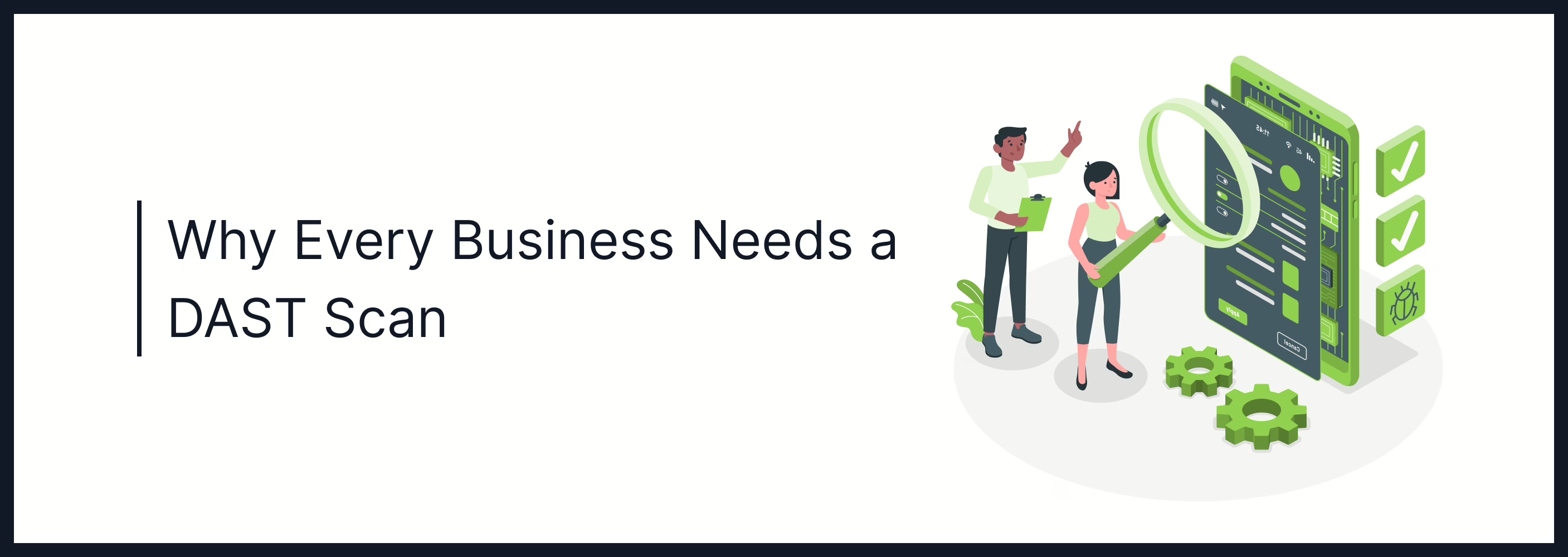
Oct 15, 2024 Information hub
Why Every Business Needs a DAST Scan: Protect Your Web Applications from Cyber Threats
In today’s digital age, where businesses are increasingly reliant on web applications, ensuring the security of these applications is paramount. Cyberattacks are becoming more sophisticated, and vulnerabilities in web applications can lead to devastating consequences, including data breaches, financial losses, and reputational damage. This is where DAST scan comes into play.
DAST (Dynamic Application Security Testing) is a critical component of modern cybersecurity strategies. It helps organizations identify vulnerabilities in their web applications by simulating real-world attacks. Unlike other security testing methods, DAST scans focus on the behavior of an application during runtime, making it an essential tool for detecting vulnerabilities that may not be apparent in the source code.
In this blog post, we will explore the significance of DAST scans, how they work, their relevance in today’s cybersecurity landscape, and the benefits they offer. We will also delve into current trends, challenges, and future developments in DAST technology. By the end of this post, you’ll have a comprehensive understanding of DAST scans and how they can help protect your web applications from potential threats.
What is a DAST Scan?
Understanding DAST
Dynamic Application Security Testing (DAST) is a type of black-box testing that focuses on identifying security vulnerabilities in web applications while they are running. Unlike SAST (Static Application Security Testing), which analyzes the source code, DAST scans interact with the application from the outside, simulating the actions of a malicious attacker.
DAST scans are designed to detect vulnerabilities such as:
- SQL Injection
- Cross-Site Scripting (XSS)
- Cross-Site Request Forgery (CSRF)
- Insecure Direct Object References (IDOR)
- Security misconfigurations
- Authentication and session management flaws
By simulating real-world attack scenarios, DAST scans provide valuable insights into how an application behaves under different conditions and whether it is susceptible to exploitation.
How Does a DAST Scan Work?
DAST scans work by sending various inputs to a web application and analyzing its responses. The goal is to identify any unexpected or insecure behavior that could indicate a vulnerability. Here’s a simplified breakdown of how a DAST scan typically works:
- Crawling the Application: The DAST tool first crawls the web application to identify all the pages, forms, and inputs that can be tested. This step is crucial for ensuring that the entire application is covered during the scan.
- Sending Malicious Inputs: Once the application has been crawled, the DAST tool sends a series of malicious inputs to the application. These inputs are designed to exploit common vulnerabilities, such as SQL injection or XSS.
- Analyzing Responses: The DAST tool then analyzes the application’s responses to these inputs. If the application behaves in an unexpected or insecure manner, the tool flags it as a potential vulnerability.
- Reporting: After the scan is complete, the DAST tool generates a report detailing the vulnerabilities it has identified. This report typically includes information about the severity of each vulnerability and recommendations for remediation.
DAST vs. SAST: What’s the Difference?
While both DAST and SAST are essential components of a comprehensive security testing strategy, they differ in their approach:
- SAST (Static Application Security Testing): SAST analyzes the source code of an application to identify vulnerabilities. It is a white-box testing method, meaning it requires access to the application’s codebase. SAST is typically used early in the development process to catch vulnerabilities before the application is deployed.
- DAST (Dynamic Application Security Testing): DAST, on the other hand, does not require access to the source code. It tests the application from the outside, simulating real-world attacks. DAST is typically used after the application has been deployed to identify vulnerabilities that may have been missed during development.
Both SAST and DAST are complementary, and using them together can provide a more comprehensive view of an application’s security posture.
The Relevance of DAST Scans Today
The Growing Threat Landscape
The cybersecurity landscape is constantly evolving, with new threats emerging every day. According to a report by Cybersecurity Ventures, cybercrime is expected to cost the world $10.5 trillion annually by 2025. Web applications are a prime target for cybercriminals, as they often contain sensitive data and are accessible from anywhere in the world.
In this context, DAST scans have become more relevant than ever. They provide organizations with a proactive way to identify and address vulnerabilities before they can be exploited by attackers. By regularly conducting DAST scans, businesses can stay one step ahead of cybercriminals and protect their web applications from potential threats.
Compliance and Regulatory Requirements
In addition to the growing threat landscape, many industries are subject to strict regulatory requirements when it comes to cybersecurity. For example, the General Data Protection Regulation (GDPR) and the Payment Card Industry Data Security Standard (PCI DSS) both require organizations to implement robust security measures to protect sensitive data.
DAST scans can help organizations meet these regulatory requirements by identifying vulnerabilities that could lead to data breaches. By addressing these vulnerabilities, businesses can demonstrate their commitment to security and avoid costly fines and penalties.
Case Study: The Equifax Data Breach
One of the most infamous examples of a web application vulnerability leading to a major data breach is the Equifax data breach of 2017. In this case, attackers exploited a vulnerability in a web application to gain access to sensitive data, including the personal information of over 147 million people.
Had Equifax conducted regular DAST scans, they may have been able to identify and address the vulnerability before it was exploited. This case highlights the importance of proactive security testing, such as DAST, in preventing data breaches and protecting sensitive information.
Benefits of DAST Scans
1. Real-World Attack Simulation
One of the key benefits of DAST scans is that they simulate real-world attacks. By testing an application from the outside, DAST scans provide valuable insights into how an attacker might exploit vulnerabilities. This makes DAST an essential tool for identifying vulnerabilities that may not be apparent through other testing methods.
2. No Access to Source Code Required
Unlike SAST, which requires access to the application’s source code, DAST scans do not require any knowledge of the underlying codebase. This makes DAST an ideal solution for testing third-party applications or applications where the source code is not readily available.
3. Comprehensive Coverage
DAST scans can test the entire application, including all pages, forms, and inputs. This ensures that no part of the application is left untested, providing comprehensive coverage of potential vulnerabilities.
4. Easy Integration into CI/CD Pipelines
Many modern DAST tools can be easily integrated into Continuous Integration/Continuous Deployment (CI/CD) pipelines. This allows organizations to automate security testing and ensure that vulnerabilities are identified and addressed early in the development process.
5. Compliance with Security Standards
As mentioned earlier, DAST scans can help organizations meet regulatory requirements and security standards, such as PCI DSS and GDPR. By regularly conducting DAST scans, businesses can demonstrate their commitment to security and avoid costly fines and penalties.
Challenges of DAST Scans
While DAST scans offer numerous benefits, they are not without their challenges. Some of the common challenges associated with DAST scans include:
1. False Positives
One of the most common challenges with DAST scans is the issue of false positives. A false positive occurs when the DAST tool flags a vulnerability that does not actually exist. This can lead to wasted time and resources as security teams investigate and address non-existent issues.
2. Limited Visibility into Source Code
Because DAST scans do not have access to the application’s source code, they may miss certain vulnerabilities that are only visible at the code level. This is why it is important to use DAST in conjunction with other testing methods, such as SAST, to ensure comprehensive coverage.
3. Performance Impact
DAST scans can be resource-intensive, especially for large and complex applications. Running a DAST scan on a production environment can sometimes impact the performance of the application, leading to slow response times or downtime.
4. Difficulty in Testing APIs
While DAST scans are effective at testing web applications, they may struggle to test APIs (Application Programming Interfaces). APIs are becoming increasingly common in modern applications, and testing them for vulnerabilities requires specialized tools and techniques.
Current Trends in DAST Technology
1. AI and Machine Learning
One of the most exciting trends in DAST technology is the integration of artificial intelligence (AI) and machine learning (ML). These technologies can help improve the accuracy of DAST scans by reducing false positives and identifying patterns that may indicate vulnerabilities.
For example, AI-powered DAST tools can analyze large datasets of past vulnerabilities to predict which areas of an application are most likely to contain security flaws. This allows security teams to focus their efforts on the most critical areas, improving the efficiency of the testing process.
2. Shift-Left Security
The concept of shift-left security involves integrating security testing earlier in the development process. Traditionally, security testing was conducted at the end of the development cycle, but with the rise of DevSecOps, organizations are now incorporating security testing into their CI/CD pipelines.
DAST tools are increasingly being designed to support shift-left security by providing seamless integration with CI/CD pipelines. This allows developers to identify and address vulnerabilities early in the development process, reducing the risk of security issues in production.
3. API Security Testing
As mentioned earlier, APIs are becoming a critical component of modern applications. In response to this trend, many DAST tools are now incorporating API security testing capabilities. This allows organizations to test their APIs for vulnerabilities and ensure that they are secure.
Future Developments in DAST
As the cybersecurity landscape continues to evolve, we can expect to see several exciting developments in DAST technology:
- Improved Accuracy: With the continued integration of AI and machine learning, DAST tools will become more accurate, reducing false positives and improving the overall efficiency of the testing process.
- Better API Testing: As APIs become more prevalent, DAST tools will continue to improve their ability to test APIs for vulnerabilities.
- Integration with Cloud Environments: As more organizations move their applications to the cloud, DAST tools will need to adapt to test cloud-based applications effectively.
Conclusion
In an era where web applications are a prime target for cyberattacks, DAST scans have become an essential tool for identifying and addressing vulnerabilities. By simulating real-world attacks, DAST scans provide valuable insights into how an application behaves under different conditions and whether it is susceptible to exploitation.
While DAST scans offer numerous benefits, including real-world attack simulation, comprehensive coverage, and easy integration into CI/CD pipelines, they are not without their challenges. False positives, limited visibility into source code, and performance impacts are some of the common issues associated with DAST scans.
However, with the integration of AI and machine learning, the rise of shift-left security, and the growing focus on API security testing, the future of DAST technology looks promising. By staying ahead of these trends and regularly conducting DAST scans, organizations can protect their web applications from potential threats and ensure compliance with security standards.
Actionable Takeaways:
- Incorporate DAST into your security strategy: Regularly conduct DAST scans to identify and address vulnerabilities in your web applications.
- Use DAST in conjunction with other testing methods: Combine DAST with SAST and other security testing methods for comprehensive coverage.
- Integrate DAST into your CI/CD pipeline: Automate security testing by integrating DAST into your CI/CD pipeline to catch vulnerabilities early in the development process.
- Stay informed about the latest trends: Keep up with the latest developments in DAST technology, such as AI-powered tools and API security testing.
By following these recommendations, you can enhance the security of your web applications and protect your organization from potential cyber threats.
